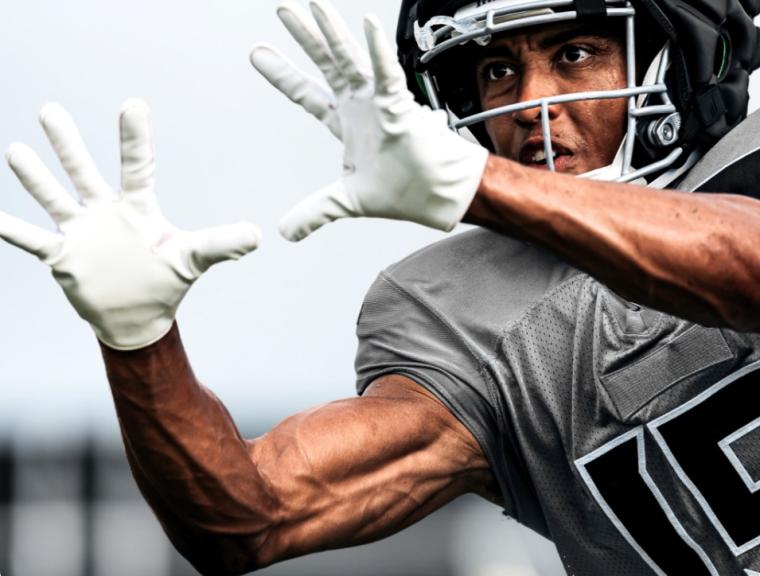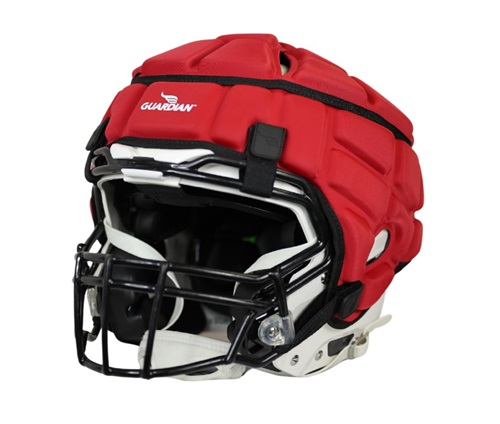
All photos courtesy of the Guardian Caps website
It all started with an e-mail to SDM writer, Michael Popke. In the email, the sender asked whether Popke (who has done much coverage of youth sports safety issues pertaining to concussion; a sample is here) had ever heard about Guardian Caps (the padded caps accepted from the NFL down to pee-wee sports) being outlawed by any youth organization.
It was a new question, to say the very least. Guardian’s Caps are accepted not just in the NFL but the CFL, at all 25 of the top-ranked college programs, at the high school level and in youth and feeder football programs.
That question spurred multiple emails, which resulted in a call back from none other than Erin Hanson, CEO and founder of Guardian Caps. And according to Hanson, pushback against the caps is coming not from the pro or even collegiate levels (nor from the National Federation of State High School Associations) but from other youth football organizations.
“This has been going on since 2012,” says Hanson. “That means we’ve been fighting this battle for 12 years. It makes me so incredibly frustrated. It doesn’t happen with the NFL or the CFL. It doesn’t happen with the NCAA. Once these higher-level programs, with access to legal teams, dig into the data and talk to other teams who have seen the benefits of Guardian Caps, they tell us we’re good to go with them.”
Ironically, that is not the case at the youth and amateur levels.
“Unfortunately, the organizations that are working with kids – the very ones with developing brains that we set out to help – they’re the ones who are telling parents and coaches that they can’t use Guardian Caps because of concerns about what the helmet companies will think and do. We see a lot of confusing language from people [who refuse to sanction Guardian Caps for practice or play],” she notes. “Sometimes they will say that using the caps will void the warranty of helmets, but I’m not sure why they’re saying that. The warranty covers the shell cracking. There’s no way a soft cover can cause a hard-shell helmet to crack.”
The Guardian Cap has four straps that pull through the facemask and attach back to themselves. The Velcro strap in the back tightens around the helmet. And according to Hanson, there is no structural change to the helmet itself; no holes are drilled, and nothing is added to or subtracted from the helmet to make the padded cap stick. It is similar to the colored pinnie caps that have been used by coaches to distinguish offense and defense for 30+ years. The only difference is that it is padded.
 “I understand that a helmet company doesn’t want you to alter their helmet,” she notes, “but we don’t do that. We don’t alter the helmet in any way at all. If you take our caps off a helmet after a season of play, for example, you’ll find no difference between the helmets without the caps and the helmets with the caps – except the helmets that were used without our caps might be more scuffed or dinged, but apart from that, it’s not like the helmet has changed at all.”
“I understand that a helmet company doesn’t want you to alter their helmet,” she notes, “but we don’t do that. We don’t alter the helmet in any way at all. If you take our caps off a helmet after a season of play, for example, you’ll find no difference between the helmets without the caps and the helmets with the caps – except the helmets that were used without our caps might be more scuffed or dinged, but apart from that, it’s not like the helmet has changed at all.”
Hanson believes the resistance comes from the helmet manufacturers, partially because helmet companies are competing for the limited budget funds at school and youth programs; adding caps to the budget could mean the sales of fewer helmets. (Another possibility is that manufacturers believe that because the Guardian Caps increase player safety, they make the original helmet look less useful.)
“They use scary language wrapped around warranty and liability to encourage volunteer youth sports coaches to forbid wearing them,” she adds.
SDM contacted helmet manufacturer Riddell for a comment about the subject; however, calls were not returned by press time.
While pushback against using Guardian Caps crops up nationwide, Hanson says that California and Washington are the two states where it is most common. And, in fact, the source of the email to SDM’s offices asking about the caps came from the west coast.
Guardian has worked with the National Operating Committee on Standards for Athletic Equipment (NOCSAE) to have caps certified but they do not offer a category for add-ons.
And various organizations have signed on. Pop Warner Little Scholars; in fact, the league notes, “The use of protective soft shell helmet covers during practices and games is allowed under the Official Pop Warner Rule Book.”
The National Federation of State High School Associations released its own statement, letting individual programs decide if they want to use the Guardian Cap. “"The NFHS does not endorse products, but it has been determined that permissive use of the Guardian Cap is not a violation of current 2024 NFHS Football Rules,” the federation noted in a statement to SDM.
Meanwhile, plenty of other groups are signing on with Guardian. American Youth Football has partnered with Guardian, and so has the Washington Interscholastic Activities Association; however, pushback remains.
In many cases, parents are cowed by coaches who threaten to bench their children if they wear the caps. Parents have long been concerned about their children getting noticed by college coaches and others who can open the door to athletic scholarships; as a result, they may not believe they are equipped to fight the leadership of organizations or that they will not be able to help their child get the attention he or she needs without being a part of the program.
The root of the problem, Hanson notes, is that “the muddled threats coming from manufacturers force people in volunteer positions to care more about protecting the helmet company’s liability than they do about better protecting players.”
SDM will continue to follow this developing issue, and will update the article as more information becomes available.


